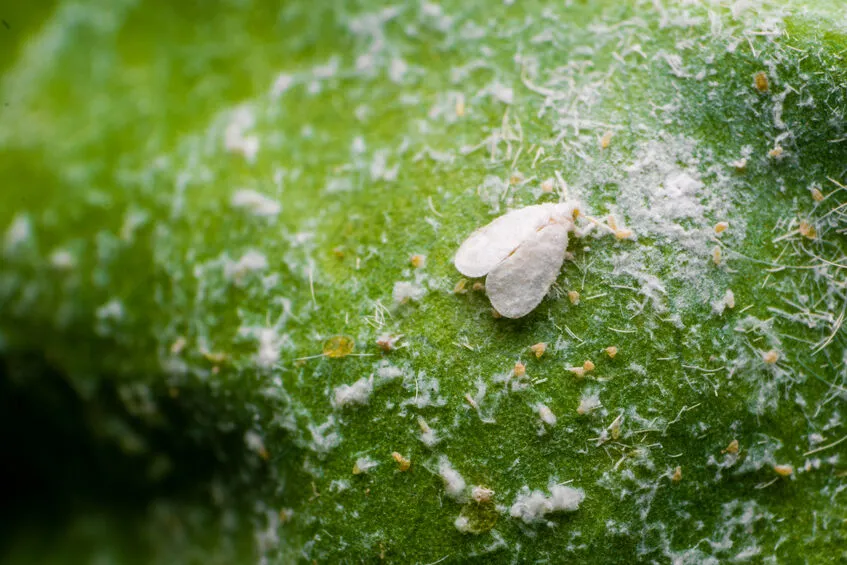When caring for your garden, you may spot small white flies on your plants. The term “whitefly” refers to over 1,500 insect species from the same family as aphids and mealybugs. Depending on where you live, various types of whiteflies can invade your plants.
These sap-sucking pests damage plants by piercing leaves and stems to feed on nutrients. Despite their tiny size—no more than 1/10 inch long—their heart-shaped bodies can cause serious harm. Below, you’ll find ways to tackle whiteflies at the first sign of trouble.
A single generation’s life cycle spans 16 to 22 days, and with overlapping generations, infestations can escalate fast if conditions stay favorable.
How to Identify Whiteflies
Adult whiteflies look like tiny, triangular moths with yellow heads. Their white, cone-shaped eggs are laid in circular patterns under leaves, near veins. These hatch into oval nymphs that crawl to feeding spots.
Whiteflies favor new growth, and adults flutter between plants. Check for sticky residue (honeydew) on leaves and stems—this signals sap-sucking pests. Honeydew also draws ants, so ants on foliage may mean whiteflies are nearby.
Whitefly Lifecycle
The lifecycle speed depends on temperature, but all six growth stages can coexist on a plant. They stay put through most stages, feeding continuously until becoming winged adults. Warm weather speeds up reproduction; cold slows it.
Signs of a Whitefly Infestation
Gently shake the plant—if a cloud of insects flies up, it’s likely whiteflies. Infestations grow quickly, but catching them early helps. Watch for gnat-like bugs around plants.
What Causes Whitefly Infestations
Stressed or soft-leaved plants attract whiteflies. Key factors include:
- Nitrogen-Rich Soil: Promotes new foliage, their preferred food. Common in greenhouses, high-nitrogen houseplant fertilizers, and early vegetable growth.
- Hot, Dry Weather: They thrive at 80–90°F, especially in greenhouses or dry gardens where plants provide moisture.
- Lack of Natural Predators: Overusing pesticides kills beneficial insects. Planting flowers near veggies can attract predators.
Common Plants Attacked by Whiteflies
Whiteflies multiply quickly on houseplants, in greenhouses, and on warm-season crops like:
- Eggplant
- Okra
- Bell Pepper
- Cabbage
- Tomato
- Sweet Potato
- Sweet Corn
Whitefly Plant Damage
Nymphs and larvae cling to plants, feeding and secreting honeydew, which fosters fungal growth and attracts ants. Sooty mold may form. While they rarely kill plants, infestations cause yellowing, leaf loss, and stunted growth—especially in greenhouses with dense plantings.
9 Ways to Get Rid of Whiteflies on Plants
- Water Spray: Blast them off with a hose (or sink sprayer for houseplants). Cover all leaves.
- Sticky Traps: Use fly tape on stakes indoors or in gardens/greenhouses.
- Insecticidal Soap: Buy premade or mix mild dish soap with water (1 tsp/gallon). Reapply as needed.
- Neem Oil: Acts as insecticide and fungicide. Safe for edibles but may require repeat treatments.
- DIY Insect Spray: Blend 1 garlic bulb, 1 onion, 1 tsp cayenne, and water. Strain, add soap, and spray. Refrigerate for up to a week.
- Pyrethrin Spray: Derived from chrysanthemums; avoid synthetic versions. Check labels for whitefly targeting.
- Warning: Toxic to fish and aquatic life. Overuse may breed resistance.
- Vacuum Adults: Use a hose attachment on houseplants to disrupt their lifecycle. Empty the vacuum outside.
- Natural Predators: Encourage ladybugs, lacewings, and birds in gardens/greenhouses. Use fans for airflow.
- Reflective Mulch: Silver/aluminum mulch confuses pests outdoors. Try foil under potted plants.
How to Prevent Whiteflies
- Isolate New Plants: Inspect and quarantine new additions. Treat infestations before bringing them inside.
- Use Predators: Move houseplants outside in summer for natural pest control. Plant predator-attracting flowers.
- Healthy Plants: Water adequately, ensure airflow, and avoid excess nitrogen.
- Repellents: Plant mint, thyme, or sage nearby, or place their leaves around indoor plants.
FAQs
Do whiteflies bite?
No—they only pierce plants.
Natural predators?
Yes: lacewings, ladybugs, dragonflies, wasps, and birds like hummingbirds.
Lifespan?
About 22 days per generation, but infestations persist without treatment.

